Production Cost Functions and Competitive Markets
Lecture 5
|
| |
Output and Costs in the Short Run
|
|
1.
Short run
- a period of time so short that at least one factor of production is fixed, usually the physical capital, like structures, machines, and equipment.
-
Total Fixed Costs (TFC)
- the costs do not change when production level changes
- Insurance premiums
- Property taxes
- Overhead from administration
- Bank loans
- Airlines, hotels, and theme parks have high fixed costs
-
Average Fixed Costs (AFC)
- fixed costs per good produced
- As production level increases, AFC will get smaller and smaller
- "Spreading the overhead"
- The fixed costs is spread out over more units
AFC = TFC / Output
| Total Fixed Cost |
Average Fixed Cost |
| Costs |
Per-Unit Costs |
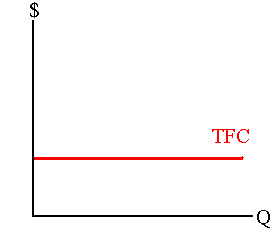
|
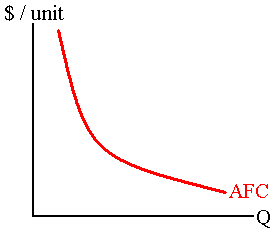
|
| Output/Quantity |
Output/Quantity |
-
Total Variable Costs (TVC)
- the costs that varies when the production level changes.
- Labor costs
- Raw material costs
- Energy costs such as electricity, water, etc.
- Labor is a large cost for many tourist related companies
-
Average Variable Cost (AVC)
- variable costs per unit of a good produced
AVC = TVC / Output
| Total Variable Costs |
Average Variable Costs |
| Costs |
Per-Unit Costs |
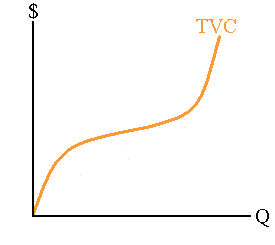
|
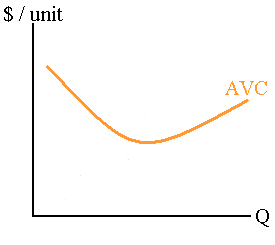
|
2.
Marginal Cost (MC)
- the increase in cost as production increases by one unit.
- MC will decline initially, reach a minimum, and then rise
- Example: A hotel starts with 0 workers
-
Specialization of labor
- Production gains
- MC decreases
- 1 worker - output is to service 10 rooms (10 rooms per worker)
- 2 workers - output is to service 30 rooms (15 rooms per worker)
- 3 workers - output is to service 60 rooms (20 rooms per worker)
-
Law of Diminishing Returns
- Output increases by a smaller and smaller amount as more labor (variable resource) is added to a fixed resource
- Production inefficiency
- Exists only in the short run
- MC increases
- 50 workers - output is to service 1,000 rooms (20 rooms per worker)
- 51 workers - output is to service 1,100 rooms (18.3 rooms per worker)
| Marginal Cost |
| Cost per unit |
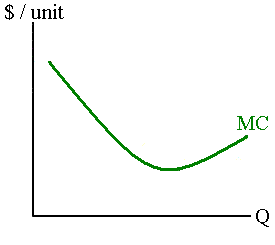
|
| Output/Quantity |
3. The Total Costs and Average Curves.
Total Cost (TC)
= Total Fixed Cost + Total Variable Cost
TC = TFC + TVC
Average Total Cost (ATC)
= Average Fixed Cost + Average Variable Cost.
ATC = AFC + AVC = TC / Output
- Relationship between marginal cost and total variable costs
- MC < ATC, then ATC is decreasing
- MC > ATC. then ATC is increasing
- MC intersects ATC at its minimum point
- Example: Student's score is 80% and student took 2 tests
- 3rd test (i.e. marginal)
- Scores 90%, average increases
- Scores 70%, average decreases
| Total Cost Curves |
Average Cost Curves |
| Total cost |
Per-unit cost |
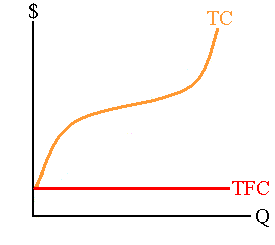
|
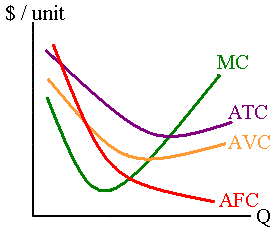
|
| Output/Quantity |
Output/Quantity |
|
Output and Costs in the Long Run
|
|
1.
Long run
- is a period of time sufficient for the firm to alter all factors of production.
- Firms can enter and exit the industry.
- Long run differs by industry.
- Examples: Long run for an automobile factory using lots of machines may be 7 years.
- The long run for an internet company may be 1 year.
-
Long-Run ATC
- shows the minimum average cost of producing each output level when a firm is able to vary all production resources, including factory size.
- Allow the firm to vary among 3 factory sizes: ATC 1
, ATC 2,
ATC 3
. Which factory size should the firm produce at?
| Long Run ATC |
| Per-Unit Cost |
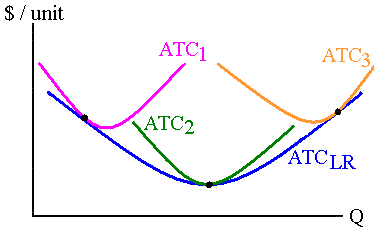
|
| Output |

|
ATC 2 will give the factory the lowest per unit costs in the long run. The firm will be able to recuperate all its total costs, when:
Market price (P*) > = minimum of long-run ATC
|
2. Why unit costs differ in the long run.
| Long Run ATC |
| Per-Unit Cost |
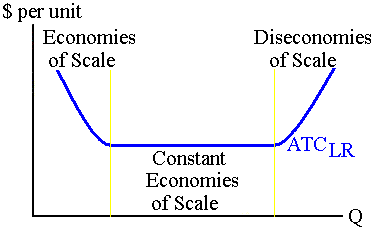
|
| Output |
-
Economies of scale
- per-unit costs fall as output (plant size) expands
- Financial - a larger firm has access to more financing options
- Buying and selling - a larger firm can buy or sell in bulk, which leads to discounts
- Mass production - large amounts of capital and machines
- Specialization of labor - adding more labor allows workers to specialize in task that they are good at
- Management specialization - people specialize in finance, personnel, and marketing
- Technical specialization - a larger firm can use more expensive technology
- Risk bearing - a larger firm can weather set backs
- Has diversified business
- Has more resources
- Concentration of competitors at tourist destination
- Competitor's advertising attracts tourists to the area
- Examples
- Automobile
- Electricity
- Natural gas
- Telecommunications including internet services
- Computer chips
-
Constant returns to scale
- per-unit costs are constant as plant size is changed.
- Small firms can be just as efficient as large firms.
- Apparel
- Food processing
- Publishing
- Lumber
- Retailing
- Wood products
-
Diseconomies of scale
- per-unit costs rises as output (plant size) expands
- Bureaucratic inefficiencies
- More difficult to coordinate and manage workers
- Monitoring and over site problems
- Tourist destination - overcrowding and congestion
3. Firms become larger through mergers
-
Merger
- firm takes over and integrates another firm
-
Horizontal integration
- firm takes over another firm in the same market
- Example - one hotel chain takes over another hotel company
- Economies of scale
- Reduce advertising
- Adjust discounts to maximize profits
- If one company owns all the hotels in one area, then it may have monopoly power
-
Vertical integration
- a firm takes over another firm in the supply chain
- An airline company that services a tourist destination buys a hotel chain there
- Company may have a cost advantage
- Gives control over the supply, and hence the quality level
- Note - many energy companies are vertically integrated
- Petroleum company extracts, refines, and sells fossil fuels to consumers
-
Conglomerate
- a firm takes over other firms in different, unrelated markets
- Diversify its products and services, and reduce risks
- Firm may leave a dying market and enter a new market
- Example - Carlson Company
- Hotels
- Restaurants
- Travel agencies
- Marketing consultant agencies
|
Pure Competition
|
-
Purely Competitive Firms
- accepts the market price in order to sell their products. They are also called
price takers
-
Characteristics:
- All firms produce an identical product
- Consumers do not care where they buy the product
- A large number of firms are in the market
- Each firm supplies only a small portion of the total supplied to the market
- One firm cannot influence the price of the market
- No barriers to entry or exit exist
- Example: If one firm earns economic profit, then rival firms can easily enter the market and try to earn profits
- The firms maximize profit by adjusting production level, but cannot influence market price.
- Examples
- Agricultural markets are competitive
- International tourist destinations can be very competitive
|
Output in the Short Run
|
|
1.
Marginal Revenue (MR)
- is the change in total revenue when output increases by one unit.
- A tour company sells airline-hotel packages at the market price
- Refer to the graph below
- If the company sells one more package, it receives $1,000 (MR). If the company sells another package, it receives another $1,000 (MR).
- If the company raises its package above the market price, then tourists do no buy it.
- Tourists buy the package from competitors for $1,000
- If the company sells his package below the market price, then it receives lower revenue (loses money)
- Thus, it sells all of its packages at the market price, so MR = P* = $1,000.
| Price Taker's Demand Curve |
| A Tour Company |
The Market |
| Price |
Price |
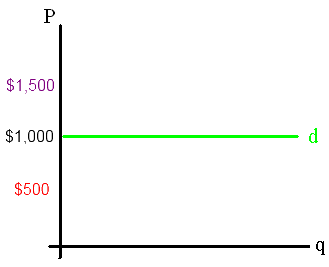
|
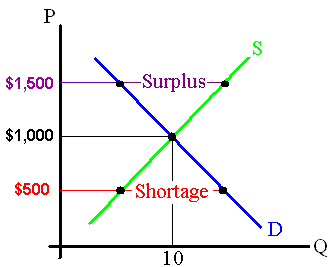
|
| Quantity |
Quantity |
2. Profit maximization - the price taker will expand output in the short run until:
P* = MR = MC
Note:
The market price is P* and marginal cost is MC. Further, the MR = MC maximizes profits for monopolies, oligopolies, and monopolistically competitive firms, while MR = P* is only valid for price takers.

|
This rule maximize the firm's profits (or minimize its losses) |
|
Example: If MR = $3 and MC = $2. MR > MC, the firm will collect $3 for selling that last "additional" unit that only costs $2 to produce. Profit increases by $1.
If MR = $3 and MC = $5. MR < MC, the firm will collect $3 for selling that last unit that costs $5 to produce. The firm should reduce production by 1 unit to increase profits.
|
- Price takers earn profits by maximizing total revenue (TR) and minimizing total costs(TC)
- Total Revenue (TR) = P * q
- Profits = TR - TC
- Taking vertical slices (adjusting output q) until TR -TC is maximized, which is shown below:
| Firm |
| $ |
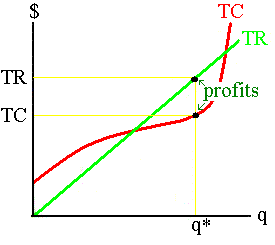
|
The point where profit is maximized is at the production level q when MC = MR = P*
| Firm |
| Price / Per-unit costs |
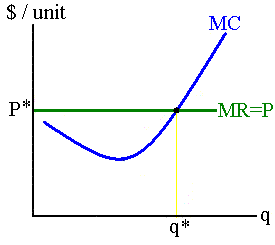
|
| Quantity |
- Using the marginal cost, market price, and average total cost, we can show a competitive firm earning a profit.
- Firm earns a profit when Market Price > ATC
- The "green" rectangle is firm's profit
- The derivation is:
Profit = Total Revenue - Total Cost
Profit = P q - ATC q = (P - ATC) q
| Firm |
| Price / Per-unit costs |
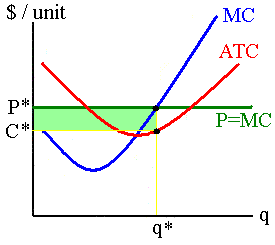
|
| Quantity |
3. Losses and going out of business.
- Firm produces quantity q where MC = MR = P
- ATC > Market Price, the firm is earning a loss, or
profit is negative
.
- Profit = Total Revenue - Total Cost
- Profit = P q - ATC q = (P - ATC) q
- The loss = "The red area"
| Firm |
| Price / Per-unit costs |
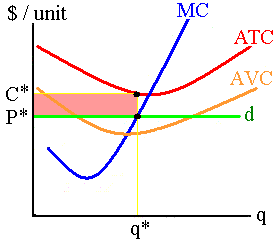
|
| Quantity |
-
Short-run.
- A firm will operate in the short run with losses, if it can cover its average variable costs.
- Example: Hotel Room
- AVC = $20 per room (labor), AFC = $10 (bank loan)
- The hotel market is competitive, so P* = MR = MC
- If P* = $15; firm cannot cover its variable costs, so it shuts down; it still pays its fixed costs
- If P* = $20; firm covers its variable costs, but earns a loss
- If P* = $25; firm still earns a loss, but also covers some of its fixed costs
- If P* = $30; firm breaks even
- If P* > $30; firm earns an economic profit
-
Shutdown
- temporary halt in the production or operation of a business.
- A firm shuts down when P* < AVC
- The firm still pays fixed costs during the shutdown.
- Motels, restaurants, and theme parks shutdown during off seasons
-
Long-run.
- A firm will "go out of business" in the long run, if P < ATC.
-
Going out of business
- firm permanently exits the market and avoids paying fixed costs
- Example - art galleries have high fixed costs
- During a recession, customer demands quickly drop
- Thus, art galleries go out of business
4. A competitive firm maximizes profits when it produces at P* = MC.
- A firm's
short-run supply curve
is its marginal cost curve above average variable cost.
- Firm produces if the market price exceeds its average variable costs.
-
Law of Supply
- as the price of a product increases, firms will increase quantity supplied.
| A Firm's Cost Curves |
A Firm's Supply Curves |
| Price / Per-unit costs |
Price / Per-unit costs |
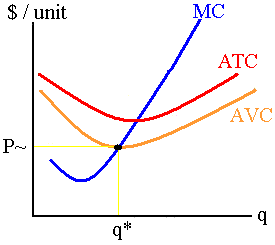
|
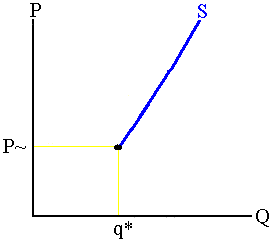
|
| Quantity |
Quantity |
|
Output Adjustments in the Long Run
|
- In the long-run, firms earn zero economic profit
- A normal rate of return, i.e. accounting profit
- If P* > ATC, firms earn an economic profit
- New firms enter the market
- SR Supply increases while the price decreases until it equals P = ATC
- Economic profit = 0
- If P* < ATC, firms earn a loss
- Some firms leave the market
- SR supply decreases, while the price increases until it equals P = ATC
- Economic profit = 0
- Long-run equilibrium
- The market determines the price and quantity of vacation packages
- P* = $1,000 and market quantity = 10 (thousand)
- Each firm supplies q quantity of travel packages
- Earn zero economic profit
- P* = ATC = $1,000
| A Travel Firm's Long-Run Cost Curve |
The Travel Package Market |
| Price / Per-unit costs |
Price / Per-unit costs |
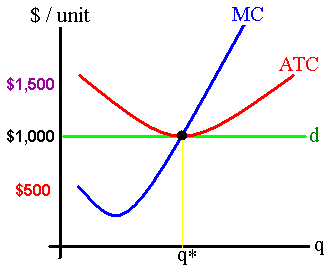
|

|
| Quantity |
Quantity (in thousands) |
- Example: The incomes in the United States increase
- Consumers buy more vacation packages (travel is a luxury good)
- The demand curve shifts right.
- New market price is P 2
- Quantity supplied and sold is Q 2
- Firms expand output to q 2
- Earn economic profits (P 2 > ATC)
- Long-run equilibrium
- New firms enter the travel vacation market
- Short-run supply increases
- Price decreases, until P 1 = ATC again
- Result:
- Same market price, P 1
- More travel packages are offered and sold, Q 3
- More firms are in the market and all earn zero economic profit
| A Travel Firm's Long Run Cost Curve |
The Travel Vacation Market |
| Price / Per-unit costs |
Price / Per-unit costs |
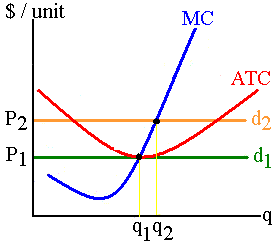
|
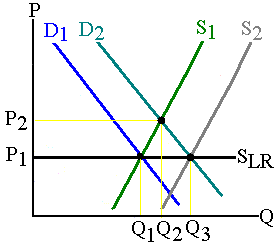
|
| Quantity |
Quantity |
- Economic losses and exit
- Example: Riots in Egypt (tastes and preferences)
- The original demand & supply curves are D 1
& S 1
- Demand curve shifts left.
- New market price is P 2
- Quantity supplied and sold is Q 2
- Firms contract output to q 2
- Earn economic losses (P 2 < ATC)
- Long-run equilibrium
- Some firms leave the hotel market
- Short-run supply decreases
- Price increases, until P 1 = ATC again
- Result:
- Same market price, P 1
- Less hotel rooms are produced and sold, Q 3
- Less firms are in the market and all earn zero economic profit
| A Hotel in Egypt |
The Hotel Market in Egypt |
| Price / Per-unit costs |
Price / Per-unit costs |
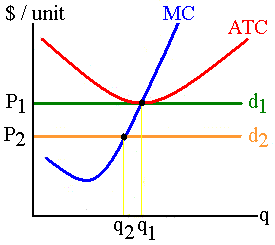
|
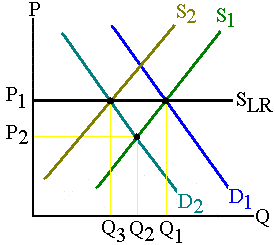
|
| Quantity |
Quantity |
-
Long-run supply
- the minimum price which firms will supply various production levels when all factors of production can be adjusted.
- The long-run supply is the black lines in the milk and rice markets
-
Constant-cost industry
- industry were resource prices remain unchanged as market output is expanded
- Long-run market supply curve is horizontal (perfectly elastic)
- Illustrated above in milk and rice markets
- An expanding/contracting industry has no impact on the resource markets, because it is a small industry
|
Terminology
|
- short run
- total fixed costs (TFC)
- average fixed costs (AFC)
- total variable costs (TVC)
- average variable cost (AVC)
- marginal cost (MC)
- specialization of labor
- Law of Diminishing Returns
- total cost (TC)
- average total cost
- long run
- long-run ATC
- economies of scale
- constant returns to scale
|
- diseconomies of scale
- merger
- horizontal integration
- vertical integration
- conglomerate
- purely competitive firm
- price takers
- marginal revenue (MR)
- shutdown
- going out of business
- short-run supply curve
- Law of Supply
- long-run supply
- constant-cost industry
|
|





















